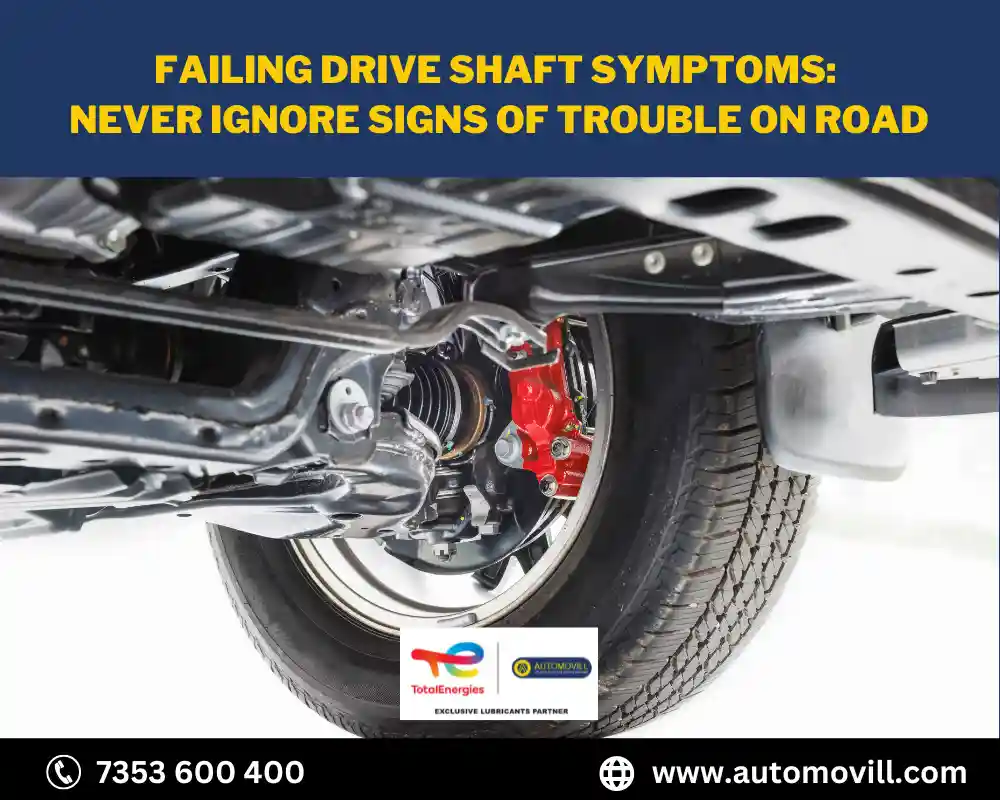
Imagine you’re going for a long drive with family on a weekend or somewhere for an important meeting. And suddenly you start to feel a subtle vibration beneath your seat. You brush it off at first, but as the miles tick by, the vibration grows more insistent, almost like a whispered plea for attention.
Little do you know, your vehicle is sending you a message through these vibrations – a message that speaks of a failing drive shaft.
It transfers power from the transmission to the wheels so that they can move efficiently and smoothly.
In this blog post, we’ll explore the symptoms of a failing drive shaft, helping you identify the signs early and take appropriate action.
Common Symptoms of a Failing Drive Shaft
If you suspect that your vehicle’s drive shaft might be failing, keep an eye out for these telltale signs:
1) Vibrations and Shaking
One of the most common symptoms of a failing drive shaft is vibrations and shaking, especially at higher speeds. If you notice a pronounced vibration that seems to originate from underneath your vehicle, it’s crucial to address it promptly.
2) Clunking Noises
Unusual clunking or banging noises when accelerating or decelerating can indicate a failing drive shaft. These noises might signify that the joints or bearings within the drive shaft are wearing out.
3) Difficulty Turning
A failing drive shaft can lead to difficulty in turning the vehicle, particularly when making sharp turns or navigating corners. This symptom could indicate a problem with the U-joints or the drive shaft’s connection to the wheels.
4) Uneven Tire Wear
If your tires are experiencing uneven wear, it could be due to a failing drive shaft. As the drive shaft loses its ability to transfer power evenly, it can lead to inconsistent tire wear patterns.
5) Drivetrain Vibrations
Vibrations felt in the drivetrain, especially when accelerating, can point to drive shaft issues. These vibrations might be accompanied by a sense of “binding” or a feeling that the power isn’t being smoothly transmitted.
6) Undercarriage Grease
Inspect the undercarriage of your vehicle. If you notice an excessive amount of grease around the drive shaft area, it could be a sign of a failing U-joint or a seal breach, allowing grease to escape.
What to Do If You Notice These Symptoms?
If you notice any of the symptoms mentioned above, it’s essential to take action promptly to prevent further damage and potential safety risks. Here’s what you should do:
1) Consult a Professional Mechanic
As soon as you notice any of the failing drive shaft symptoms, consult a professional mechanic with experience in drivetrain and suspension systems. They can conduct a thorough inspection to identify the exact cause of the issue.
2) Repair or Replacement
Depending on the severity of the drive shaft’s condition, the mechanic will recommend either repairs or replacements. In some cases, only specific components like U-joints might need replacement, while in more severe cases, the entire drive shaft assembly needs to be replaced.
3) Regular Maintenance
Prevention is key to avoiding drive shaft problems. Regularly scheduled maintenance can help identify potential issues before they become major problems. Be sure to follow your vehicle manufacturer’s recommended maintenance schedule.
Maintaining Your Drive Shaft and Vehicle
Beyond addressing drive shaft issues, it’s important to adopt a proactive approach to vehicle maintenance. Here are some additional tips to help keep your vehicle running smoothly:
1) Regular Inspections
Schedule regular inspections with a certified mechanic to catch potential problems before they escalate. Mechanics can identify early signs of wear and tear, helping you address them before they lead to major issues.
2) Grease and Lubrication
Proper lubrication is crucial for the smooth functioning of your vehicle’s components, including the drive shaft. Timely service and maintain the lubrication of the drive shaft’s joints to prevent premature wear.
3) Balanced Driving
Avoid aggressive driving, abrupt accelerations, and sudden stops, as these actions can place excessive strain on the drive shaft and related components. Maintaining a balanced driving style can contribute to the longevity of your vehicle’s drivetrain.
4) Road Conditions
Be mindful of the road conditions you’re driving in. Potholes, rough terrain, and debris can put stress on the drive shaft and suspension components. You should always drive slowly and with utmost care on uneven roads to minimize the strain on the suspension of your car.
Conclusion
Recognizing the symptoms of a failing drive shaft can save you from unexpected breakdowns and costly repairs. If you experience any of the mentioned signs, don’t delay in seeking assistance from a skilled automobile mechanic.
By addressing drive shaft issues promptly, you’ll ensure your vehicle’s safety, performance, and longevity on the road.
